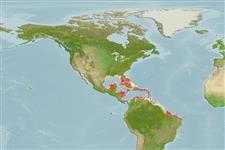Common names from other countries
Classification / Names / Names
Common names | Synonyms | Catalog of Fishes (gen., sp.) | ITIS | CoL | WoRMS
Environment: milieu / climate zone / depth range / distribution range
Ecology
Reef-associated; depth range 0 - 24 m (Ref. 83934). Tropical; 34°N - 18°S, 97°E - 32°E (Ref. 83435)
Western Atlantic: North Carolina to Brazil, Bermuda.
Length at first maturity / Size / Weight / Age
Maturity: Lm ? range ? - ? cm Max length : 3.6 cm DL male/unsexed; (Ref. 83435)
Maximum depth from Ref. 109264.
Life cycle and mating behavior
Maturity | Reproduction | Spawning | Eggs | Fecundity | Larvae
Members of the order Patellogastropoda are mostly gonochoric and broadcast spawners. Life cycle: Embryos develop into planktonic trocophore larvae and later into juvenile veligers before becoming fully grown adults.
Rodríguez-Sevilla, L., R. Vargas and J. Cortés. 2009. (Ref. 83934)
IUCN Red List Status (Ref. 130435: Version 2024-1)
CITES status (Ref. 108899)
Not Evaluated
Not Evaluated
Human uses
| FishSource |
Tools
More information
Age/Size
Growth
Length-weight
Length-length
Morphology
Larvae
Abundance
Internet sources
Estimates based on models
Preferred temperature
(Ref.
115969): 25.5 - 28.2, mean 27.3 (based on 505 cells).
Vulnerability
Low vulnerability (10 of 100).
Price category
Unknown.
